Episode 3
Two Worlds -
One Spirit
Written
& directed by
ADRIAN REDMOND
Production number 601-101C
Filmed in Alaska 1998-2000
Post production in Denmark 2001
Duration 59 minutes (English version)
Stereo PAL and NTSC
Non-broadcast release on VHS and DVD
Also available in
Danish and Greenlandic |
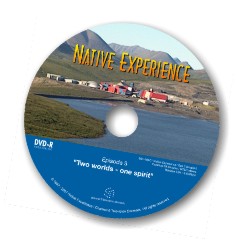 |
|
| |
| Natives
and industry in partnership |
| |
 |
When
the first whalers, gold prospectors and missionaries
came to Northwest Alaska over 150 years ago, they
met the Inupiat Eskimos, whose culture and
subsistence lifestyle had hardly changed in 10,000
years.
Within a few decades, the outsiders had changed the
Native culture irrevocably. They converted the
Inupiat to Christianity, they introduced them to
firearms and modern hunting technology, and the
foundation for a cash-economy had been laid. |
|
|
| Over
the next 60 years, the Americanization of the
Inupiat and Alaska’s other indigenous peoples
continued gradually, limited only by the isolation
of Alaska, and the primitive lifestyle which any
outsider had to accept when settling in the Great
Land. |
 |
|
| |
 |
With
the discovery of oil in Prudhoe Bay in 1967, and
the subsequent passing of the Alaska Native Claims
Settlement Act, Alaska became a magnet for
outsiders who were willing to endure a harsh
working environment for the opportunity to earn
their fortune and create a new life for their
families. In the course of the next 30 years, the
newcomers would increase Alaska’s population
fivefold. |
|
| |
| The
Natives of the Northwest Arctic Region became the
owners of mineral rich lands in the De Long
Mountains, where a substantial zinc and lead
deposit had been discovered. Together with the
Canadian Mining company Cominco, the Inupiat
people established Red Dog Mine, which, within a
few years, proved to be one of the richest zinc
deposits in the world. |
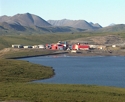 |
|
| |
 |
Unlike
most mining operations in remote Arctic regions,
where the local population have little influence
over the course of industrial development.
Red Dog Mine lies on Native-owned land, so the
Natives could dictate many of the terms on which
development could take place. |
|
| |
After
12 years of operation, over half of the employees
at Red Dog Mine are Native shareholders, and the
impact on subsistence resources has been
minimal.
Red Dog has made an important contribution to the
economy of the region. |
 |
|
| |
| This
is the story of Red Dog Mine and the many changes which
economic development has brought to the Native communities
of the Northwest Arctic Region. |
| |
|
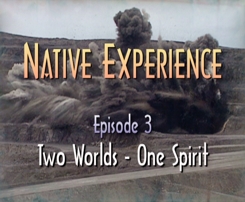
|
| |
| "Two
Worlds - One Spirit" is a term often used by the
Inupiat of the Northwest Arctic Region to describe the
philosophy which with which they address their daily lives
- echoing their desire to apply their traditional Inupiat
values to the task of municipal government, corporate
leadership, and educating and bringing up their children. |
| |
 |
This
principal shooting of this film took place in the
summer of 1999 - starting in the City of Kotzebue
and the Native village of Noatak, and ending at
Red Dog Mine.
We arrived in Noatak on a Wednesday morning in
June 1999, with a handful of contacts and few
arrangements for our visit made in advance. |
|
| |
The
villagers of Noatak welcomed us. A local hunter
(who also figures in our story) Ricky Ashby, was
away on a hunting trip, but lent us his
house.
Over a period of three weeks, we gathered
interviews and footage of village life, explored
the waters of the Noatak River and saw at first
hand the majestic territory which has been home to
these people since time immemorial. |
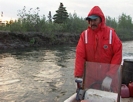 |
|
| |
| Filming
in a Native community always carries with it one
unavoidable disappointment - the discovery that many of
the villagers whose interviews one wishes to record or
whose daily life one seeks to document are away from the
village at that time. |
| |
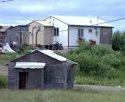 |
Bush
communities are not like towns in Europe or the
lower 48 states - their status as permanent
settlements (most often historically dictated by
the laws of outsiders seeking to hold the
population in a few permanent communities in which
churches, schools and municipal services can
thrive) is permanent in name only. A century colonization,
most citizens in rural Alaska continue to migrate
in search of the subsistence resources on which
they depend. |
|
| |
Their
hunting grounds are easily as large as the sales
territory of most western corporate
executives.
The difference for Native people though, is that
they take time - a lot of time - to pursue their
subsistence activities, often traveling as entire
families to camps on the coast, to which they
return every year. |
 |
|
| |
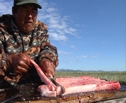 |
So
many of the people of Nuiqsut whom we interviewed
or filmed for this story, were to be found at
their summer camp in Shesaulik on the north
western shores of Kotzebue Sound. Inuit who live
in land still depend on the ocean for much of
their food. Kotzebue Sound has been a traditional
summer gathering place for the Inupiat for
centuries - the waters here are rich in marine
mammals - Beluga whale, seal, walrus - and of
course many species of fish and migratory
waterfowl. |
|
| |
Land
mammals such as caribou may also be hunted in the
area during the annual migrations.
Noatak Hunter Ricky Ashby showed us how he
preserves his subsistence food for the winter. |
 |
|
| |
 |
From
Shesaulik we were able to film a walrus hunt on
the sea ice far offshore. Walrus live in large
groups on the edge of the sea ice close to the
open sea. In the late 19th century American
whalers hunted the Bering Sea walrus population so
ruthlessly, that the Inupiat population in many
areas were left without food and many died from
starvation. Today commercial hunting of walrus is
prohibited, only indigenous people may hunt the
walrus. |
|
| |
| When
a walrus is killed, the rest of the herd remains
close by, so the hunters much approach with care -
one swipe from the tusks of a bull walrus could
flay their wooden boat in seconds. The hunters
butcher their catch on the ice, and sail the much
sought-after blubber and meat home to Shesaulik,
where it will be processed and preserved for the
coming winter. |
 |
|
| |
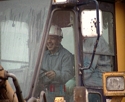 |
This
film is a contrast between traditional village
life, and the working life of those Natives who
are employed at Red Dog Mine - the world's richest
lead and zinc mine in the De Long mountains above
the Noatak River.
The goal set by NANA and Cominco here is 100%
Native shareholder hire. |
|
| |
| At
first sight, an industrial mining operation
represents everything a Native culture despises in
the industrial world's relationship with mother
earth - and such attitudes were the reason that
the Natives of the Northwest Arctic region were
more than reluctant to develop the mineral deposit
at Red Dog. For the Natives, the idea of getting
into the mining business took over a decade to
mature. |
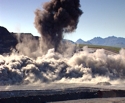 |
|
| |
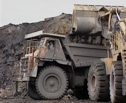 |
The
Alaska Native Lands Claims Settlement Act resulted
in the Native regional corporation of Northwest
Alaska (NANA) achieving land ownership of the
mineral deposit - and their ultimate choice to
develop this resource - in partnership with the
Canadian mining company Cominco - was founded on
the belief that this endeavour could be managed
according to the "Two Worlds - One
Spirit" philosophy. |
|
| |
They
believed that Native control - via land ownership
- could give them more than an economic stake in
the exploitation of their mineral wealth - it
could also provide the framework for employment,
education and Native empowerment within the entire
region.
This episode illustrates the history of the region
and tells the story of Red Dog Mine. |
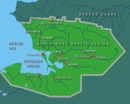 |
|
| |
| The
following contributed to this film with their interviews - |
| |
Willie Hensley
Ricky Ashby
Reggie Joule
Rachel Sherman
Ben Sherman
John Schaeffer
Doug Horswill
Jim Kulas
Robbie Kirk
Frederica Schaeffer
Frank Adams Jr.
Isaac Smith
|
| |
 |
At
the time of its inception, Red Dog Mine was a
unique and daring experiment in the field of
commercial partnership between native communities
and an international mining corporation. Today,
almost 20 years since the signing of the
partnership agreement, Red Dog stands as a model
to inspire indigenous people all over the world in
the development of their natural resources. |
|
| |
| "Two
Worlds - One Spirit" attempts to describe an
individual mining project and provide the viewer
with an insight into the many issues which arise
when balancing the profitable and efficient
operation of a mine with the needs and values of
the local indigenous population. |
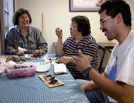 |
|
| |
| This
film makes a valuable contribution towards documenting the
history of the Alaska Native Claims Settlement Act and is
recommended viewing for Native and non-native audiences
alike. |
| |
|

|
| |
|
This film
is dedicated to the children of the Arctic
that they may grow
to walk in two worlds with one spirit.
|
|
|